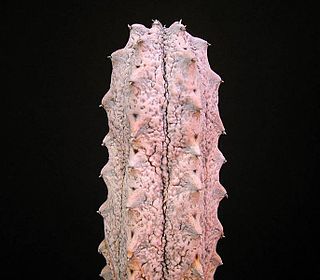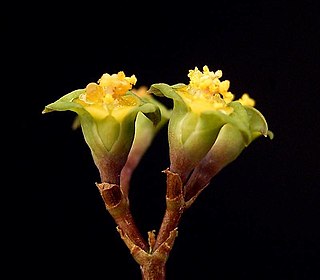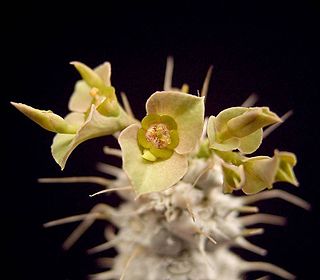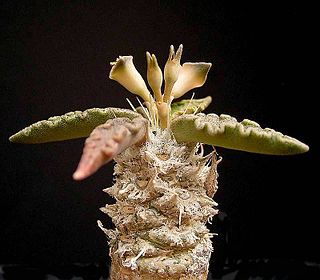
Euphorbia abdelkuri is a species of plant in the family Euphorbiaceae. It is endemic to Abd al Kuri, an island south of Yemen. Its natural habitat is rocky areas. The Latex of the plant is toxic.

Euphorbia ambovombensis is a species of plant in the family Euphorbiaceae. It is endemic to Madagascar. It is native to the area around Ambovombe at the southern end o the island, where it is locally common. Its natural habitats are subtropical or tropical dry forests and subtropical or tropical dry shrubland. It is threatened by habitat loss.

Euphorbia ankarensis is a species of plant in the family Euphorbiaceae. It is endemic to Madagascar. Its natural habitat is rocky areas. It is threatened by habitat loss.

Euphorbia arbuscula is a species of plant in the spurge family (Euphorbiaceae). It is endemic to the archipelago of Socotra in Yemen. Its natural habitats are subtropical or tropical dry forests and subtropical or tropical dry shrubland.

Euphorbia beharensis is a species of plant in the family Euphorbiaceae. It is endemic to Madagascar. Its natural habitats are subtropical or tropical dry forests and subtropical or tropical dry shrubland. It is threatened by habitat loss.

Euphorbia cap-saintemariensis is a species of plant in the family Euphorbiaceae. It is endemic to Madagascar. Its natural habitat is rocky areas. It is threatened by habitat loss.

Euphorbia cylindrifolia is a species of plant in the family Euphorbiaceae. It is endemic to Madagascar. Its natural habitats are subtropical or tropical dry forests and subtropical or tropical dry shrubland. It is threatened by habitat loss.

Euphorbia didiereoides is a species of plant in the family Euphorbiaceae. It is endemic to Madagascar. It is threatened by habitat loss.

Euphorbia geroldii commonly called Gerold's Spurge or Thornless Crown of Thorns a species of plant in the family Euphorbiaceae. It is endemic to Madagascar. Its natural habitat is subtropical or tropical dry forests. It is threatened by habitat loss.
Euphorbia leistneri is a species of succulent plant in the family Euphorbiaceae. It is endemic to northwest-Namibia and southwest-Angola near the Kunene river. Its natural habitat is subtropical or tropical dry shrubland. It is threatened by habitat loss. Euphorbia leistneri is closely related to Euphorbia monteiri.

Euphorbia neobosseri is a species of plant in the family Euphorbiaceae It is endemic to Madagascar. Its natural habitats are subtropical or tropical dry forests and subtropical or tropical dry shrubland. It is threatened by habitat loss.

Euphorbia parvicyathophora is a species of plant in the family Euphorbiaceae. It is endemic to South-West Madagascar. The Euphorbia parvicyathophora typically lives in an environment that is of rocky material; particularly, limestone is its primary locale of habitation. Euphorbia parvicyathophora grows within the soil pockets of cavernous limestone along the southern bank of the Fiherenana river, a river in the southern part of Madagascar, which flows to the Indian Ocean. Euphorbia parvicyathophora is threatened by habitat loss.

Euphorbia platyclada is a species of plant in the family Euphorbiaceae. It is endemic to Madagascar. Its natural habitat is subtropical or tropical dry forests. It is threatened by habitat loss.
Euphorbia quitensis is a species of plant in the family Euphorbiaceae. It is endemic to Ecuador. Its natural habitat is subtropical or tropical moist montane forests.

Euphorbia tulearensis is a species of plant in the family Euphorbiaceae. It is endemic to Madagascar. Its natural habitat is rocky areas. It is threatened by habitat loss.
Gymnocarpos kuriensis is a species of plant in the family Caryophyllaceae. It is endemic to the islands of Socotra and Abd al Kuri in Yemen. Its natural habitats are subtropical or tropical dry forests, subtropical or tropical dry shrubland, and rocky areas.
Polycarpaea kuriensis is a species of plant in the family Caryophyllaceae. It is endemic to Yemen. Its natural habitats are subtropical or tropical dry shrubland and rocky areas.
Polygala kuriensis is a species of plant in the family Polygalaceae. It is endemic to Yemen, where it is found on the island of Socotra. Its natural habitats are subtropical or tropical dry shrubland and rocky areas.
Portulaca kuriensis is a species of flowering plant in the purslane family, Portulacaceae, that is endemic to Yemen. Its natural habitats are subtropical or tropical dry shrubland and rocky areas.
Ruellia kuriensis is a species of plant in the family Acanthaceae. It is a subshrub endemic to the island of Abd al Kuri in the Socotra archipelago off the coast of northeastern Africa, which is politically part of Yemen. Its natural habitat is subtropical or tropical dry shrubland.













